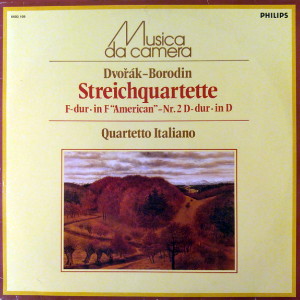 |
|
Philips
- 1 LP - 6503 109
|
|
QUARTETTO ITALIANO
- Paolo Borciani, Elisa Pegreffi, violino
- Piero Farulli,
viola
- Franco Rossi, violoncello |
|
|
|
|
|
Luogo e data
di registrazione |
|
Het
Wapen Van
Eindhoven,
Eindhoven
(Olanda) - 17-22
febbraio 1968 |
|
|
Registrazione: live
/ studio |
|
studio |
|
|
Producer / Engineer |
|
Vittorio Negri |
Willem
van Leeuwen |
|
|
Edizione LP |
|
Philips | 6503
109 | 1 LP |
|
|
Prima Edizione CD |
|
Vedi link alla prima
edizione in long playing.
|
|
|
Note |
|
La
collana
"Musica da
Camera" della
Philips
riedita negli
anni
'80
alcune
registrazioni
del Quartetto
Italiano. |
|
|
|
|
In
many ways Dvořák's
"American"
Quartet is the
chamber music
equivalent of
his "New
World"
Symphony. Both
were written
in 1893; both
are his most
popular works
in their
respective
fields; and
both have
nicknames
which have
proved
dangerously
misleading.
The titles
mean little
more than
"composed in
America"
although
people have
persisted in
believing that
the works are
full of
American
folk-melodies.
As
director
of the National
Conservatory
of Music in
New York. Dvořák
stayed in America
for three
years in all.
He did not,
however, find
the bustle of
the city very
conducive to
composition
and, when
he heard of a
Czech village
settlement at
Spillville in
Iowa he lost
no time in
arranging to
spend his
summer
vacations
there. In this
peaceful
atmosphere he
began the F major
String Quartet
on June 8,
1893 and by
June 23 it was
complete.
The
first movement
is in sonata
form,
although Dvořák
gives us two
themes in his
second subject
group. The
melodies are
mainly
pentatonic,
lending them a
distinct
folk-like air.
Nostalgia is
apparent in
the lyrical
yet intense
slow movement
in D minor,
which is
followed by a
scherzo in F
built around
one theme. The
simple
elements of
this are
derived from
the song of a
bird the
composer saw
in Spillville.
(He described
it as a red
bird with only
the wings
black -
probably a
scarlet
tanager, a
summer visitor
to Iowa, like
a Dvořák.)
The finale is
a rondo with a
central
episode in
which Otakar
Sourek hears a
reminiscence of
the little
Spillville
church where
Dvořák
played the
organ daily.
Borodin's,
like that of Dvořák,
presents
national
feeling within
a classical
framework. As
a result his
two string
quartets have
taken their
place as both
great Russian
and great
European
works. The
second
quartet, the
more popular
of the two,
was begun in
August 1881,
and Borodin's
biographer,
Serge Dianin,
claims it was
completed by
the end of the
month to mark
the twentieth
anniversary of
Borodin's
engagement.
The work is,
in fact,
dedicated to
the composer's
wife who, by
all accounts,
was
sentimental
about such
remembrances,
and this may
account for
the work's
heavily
romantic
flavour.
Dianin goes
farther and
tentatively
suggest
(without any
real evidence)
a programme in
which the
movements
recall periods
of courtship
and marriage.
There
are three
themes in the
lyrical first
movement. The
second, built
around a
fragment of
the first
appears in F
sharp minor.
The third,
subsidiary
theme assumes
a martial air
before giving
way again to
the second
subject. There
is no trio
with the
scherzo which
follows:
instead we
have two
themes - a
bustling first
subject and a
waltz-like
duet on the
violins
("Baubles,
Bangles, and
Beads" in the
musical "Kismet").
The
Notturno has
been made
popular in
several
adaptations,
notably "And
this is my
beloved" in
"Kismet."
None, however,
has matched
the beauty of
the original.
Again
there are two
subjects. The
finale opens
with two
"question and
answer"
figures which
inevitably
recall the
"Muss es sein?
Es muss sein!"
of Beethoven's
Op. 135. These
figures are
ingeniously
combined in
the Vivace
as they lead
to the
chromatic
second subject.
A.
David Hogarth
|
| Illustration:
Karl Haider (1846-1912)
"Leutstettener
Vorfrühlingslandeschaft"
(Kunsthalle, Mannheim)
|
|